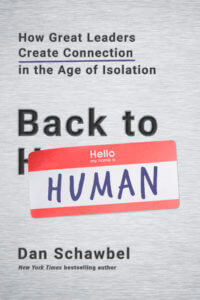 Dan Schawbel has made a living researching and writing about Millennials. As a member of the the generation born between 1981 and 1996, he’s in a unique position to offer career advice about this much-discussed demographic. Schawbel’s two previous books (Me 2.0, for recent college grads and Promote Yourself, for Millennials aspiring to leadership roles) have tracked his own career progression. Now, with the launch of his latest book, Back to Human: How Great Leaders Create Connection in the Age of Isolation, he takes on the next logical progression in many Millennials’ career paths: what to do when one achieves the position of leader.
Dan Schawbel has made a living researching and writing about Millennials. As a member of the the generation born between 1981 and 1996, he’s in a unique position to offer career advice about this much-discussed demographic. Schawbel’s two previous books (Me 2.0, for recent college grads and Promote Yourself, for Millennials aspiring to leadership roles) have tracked his own career progression. Now, with the launch of his latest book, Back to Human: How Great Leaders Create Connection in the Age of Isolation, he takes on the next logical progression in many Millennials’ career paths: what to do when one achieves the position of leader.
Back to Human starts with a sobering premise: workers across the globe are experiencing a crisis of loneliness, both at work and at home. Schawbel is the Research Director at Future Workplace. For Back to Human, Future Workplace partnered with Virgin Pulse to survey over 2,000 managers and employees globally on their workplace experiences. Their research found that employees in the Millennial demographic were especially vulnerable to isolation, even with all the access to social media and other technology that should, in theory, aid in connection rather than isolate workers.
As more Millennials move into leadership roles, Schawbel sees an opportunity to change this dire social circumstance. He wrote Back to Human to help new leaders “create a workplace in which your teammates feel genuinely connected and engaged.” Far from being a tech-bashing read, this book helps leaders decide when and how to most appropriately use technology to build better connections at work.
Back to Human is organized into three sections. Part I, “Master Self-Connection”, focuses on optimizing your sense of fulfilment and productivity. Part II, “Create Team Connection” directs its attention to ways that leaders can foster connection with team members through promoting diverse ideas, embracing collaboration and understanding the power of recognition. Part III, “Building Organizational Connection” describes the key role that leaders play in building organizational capability through hiring, developing and retaining employees.
Should you read this book? Here are my 5 reasons I think you should read Back to Human:
- Throughout the book, Schawbel offers real-life dialogue snippets between a leaders and employee to demonstrate how to employ his suggestions; this adds reality and an actual “what-to-say-when” template for new leaders
- Back to Human offers specific scenarios for how to address potentially tricky situations regarding leaders who must manage an employee who is a decade (or more) older
- Sprinkled throughout the book are suggested team activities, leadership “exercises” (specific actions to take to drive engagement with employees) and other very practical “how to” tips that correlate to each of the chapters topics.
- Chapter 6, Reward through Recognition, offers one of the most succinct, yet information-packed chapters on the benefits of providing recognition to your employees. Spoiler alert: it has nothing to do with money
- In Chapter 7, Hire for Personality, Schawbel offers very specific interview questions as well as the reasons behind why these are good interview questions
In Back to Human’s introduction, Schawbel promises to walk the reader through “everything you need to do” to build a more connected workforce. Given the charts, explanations and many real-life “here’s what you say when this happens” format of Back to Human, I’d say he absolutely delivers. This is an excellent primer for an early-career leader who struggles with the challenge of balancing today’s relentless drive of technology with a more human-centric approach to leading.
This is a great resource, I have this book and refer to it often. I have been reading Warren Wright’s book as well called Second Wave Millennials. secondwavelearning.com is his site for it. Wright has a great handle on this young work force and how we can get them to be productive and work within our systems. It’s quite good.
A workplace where everyone is genuinely connected and engaged, generally has a really good work environment.